Investigating Factors Affecting Online Auctions: A Research Proposal
VerifiedAdded on 2022/08/29
|19
|4869
|20
Report
AI Summary
This research proposal investigates the factors affecting online auctions, with a focus on consumer confidence, online fraud, financial access, and consumer rights. The study begins with an introduction to the online auction business and its significance in e-commerce, particularly highlighting the role of platforms like eBay. The research poses both general and specific questions to guide the investigation, including inquiries into the current forms of online fraud, the implementation of consumer protection, and the proper methods for preventing fraud. A conceptual framework is proposed to illustrate the relationships between these factors. The literature review explores consumer confidence, financial access, cross-border shopping, payment methods, and online fraud, citing relevant research and studies. It delves into specific methods of victimization in online auctions, such as fee stacking, black market activities, triangulation, multiple bidding, and shill bidding. The proposal also addresses the significance, limitations, delimitations, and ethical issues associated with the research. The methodology is qualitative, with a focus on peer-reviewed sources to answer the research questions. The expected outcome is to provide insights into how consumer behavior, fraud, and financial access influence the online auction environment. The research concludes by summarizing the key findings and providing a list of references.
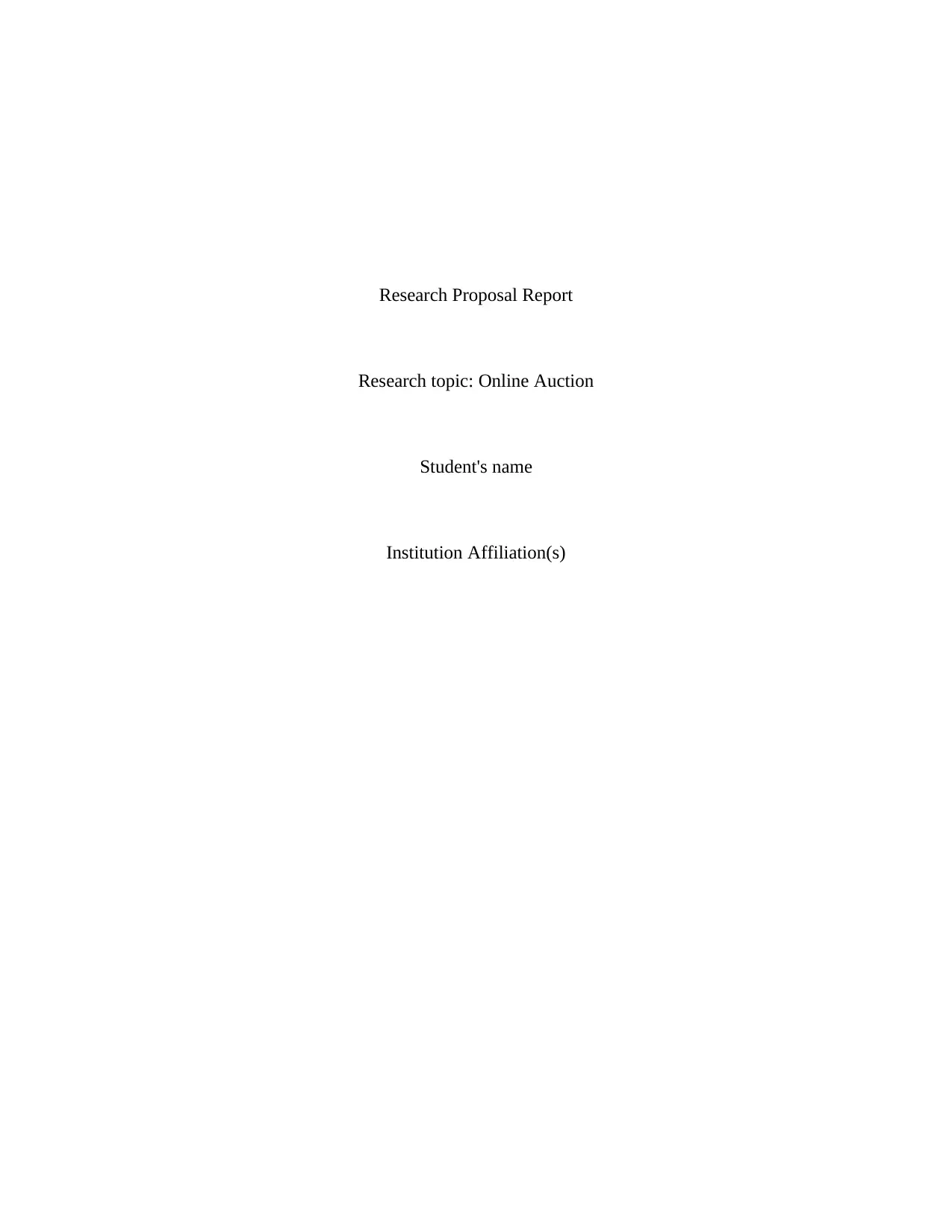
Research Proposal Report
Research topic: Online Auction
Student's name
Institution Affiliation(s)
Research topic: Online Auction
Student's name
Institution Affiliation(s)
Paraphrase This Document
Need a fresh take? Get an instant paraphrase of this document with our AI Paraphraser
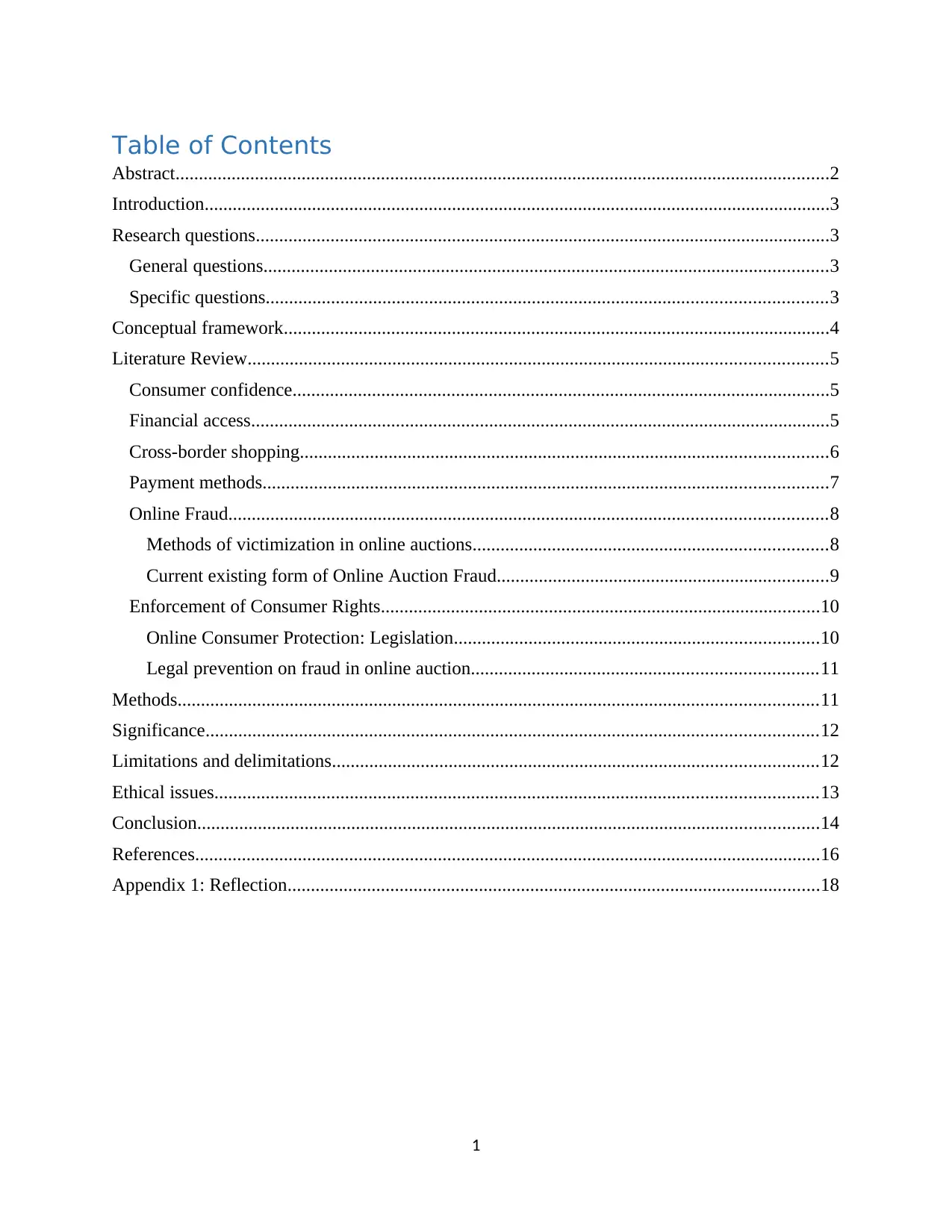
Table of Contents
Abstract............................................................................................................................................2
Introduction......................................................................................................................................3
Research questions...........................................................................................................................3
General questions.........................................................................................................................3
Specific questions........................................................................................................................3
Conceptual framework.....................................................................................................................4
Literature Review............................................................................................................................5
Consumer confidence...................................................................................................................5
Financial access............................................................................................................................5
Cross-border shopping.................................................................................................................6
Payment methods.........................................................................................................................7
Online Fraud................................................................................................................................8
Methods of victimization in online auctions............................................................................8
Current existing form of Online Auction Fraud.......................................................................9
Enforcement of Consumer Rights..............................................................................................10
Online Consumer Protection: Legislation..............................................................................10
Legal prevention on fraud in online auction..........................................................................11
Methods.........................................................................................................................................11
Significance...................................................................................................................................12
Limitations and delimitations........................................................................................................12
Ethical issues.................................................................................................................................13
Conclusion.....................................................................................................................................14
References......................................................................................................................................16
Appendix 1: Reflection..................................................................................................................18
1
Abstract............................................................................................................................................2
Introduction......................................................................................................................................3
Research questions...........................................................................................................................3
General questions.........................................................................................................................3
Specific questions........................................................................................................................3
Conceptual framework.....................................................................................................................4
Literature Review............................................................................................................................5
Consumer confidence...................................................................................................................5
Financial access............................................................................................................................5
Cross-border shopping.................................................................................................................6
Payment methods.........................................................................................................................7
Online Fraud................................................................................................................................8
Methods of victimization in online auctions............................................................................8
Current existing form of Online Auction Fraud.......................................................................9
Enforcement of Consumer Rights..............................................................................................10
Online Consumer Protection: Legislation..............................................................................10
Legal prevention on fraud in online auction..........................................................................11
Methods.........................................................................................................................................11
Significance...................................................................................................................................12
Limitations and delimitations........................................................................................................12
Ethical issues.................................................................................................................................13
Conclusion.....................................................................................................................................14
References......................................................................................................................................16
Appendix 1: Reflection..................................................................................................................18
1

Abstract
The online auction has been on the rise with giant tech companies such as eBay on the
forefront. However, with the growth in this sector that highly depends on cyber-security
standards to operate, there are many opportunities and threats to the trade. This research aims at
investigating factors that affect the online auction. A literature review will be conducted, and
peer-reviewed sources used in answering the research questions. A qualitative methodology has
been adopted for the study. Results indicate that consumer confidence, online fraud, financial
access and consumer rights all affect the decision making of a buyer in an online auction.
2
The online auction has been on the rise with giant tech companies such as eBay on the
forefront. However, with the growth in this sector that highly depends on cyber-security
standards to operate, there are many opportunities and threats to the trade. This research aims at
investigating factors that affect the online auction. A literature review will be conducted, and
peer-reviewed sources used in answering the research questions. A qualitative methodology has
been adopted for the study. Results indicate that consumer confidence, online fraud, financial
access and consumer rights all affect the decision making of a buyer in an online auction.
2
⊘ This is a preview!⊘
Do you want full access?
Subscribe today to unlock all pages.

Trusted by 1+ million students worldwide
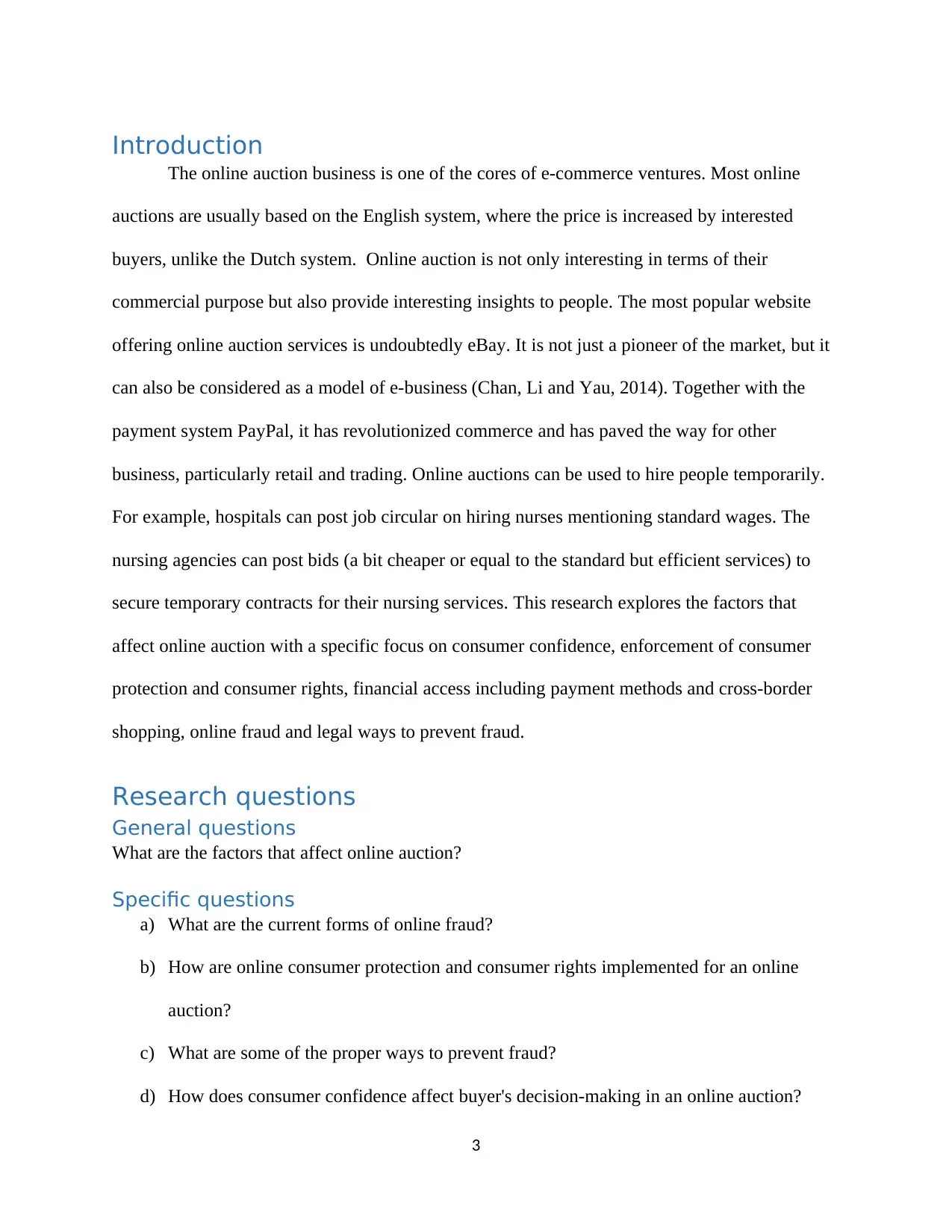
Introduction
The online auction business is one of the cores of e-commerce ventures. Most online
auctions are usually based on the English system, where the price is increased by interested
buyers, unlike the Dutch system. Online auction is not only interesting in terms of their
commercial purpose but also provide interesting insights to people. The most popular website
offering online auction services is undoubtedly eBay. It is not just a pioneer of the market, but it
can also be considered as a model of e-business (Chan, Li and Yau, 2014). Together with the
payment system PayPal, it has revolutionized commerce and has paved the way for other
business, particularly retail and trading. Online auctions can be used to hire people temporarily.
For example, hospitals can post job circular on hiring nurses mentioning standard wages. The
nursing agencies can post bids (a bit cheaper or equal to the standard but efficient services) to
secure temporary contracts for their nursing services. This research explores the factors that
affect online auction with a specific focus on consumer confidence, enforcement of consumer
protection and consumer rights, financial access including payment methods and cross-border
shopping, online fraud and legal ways to prevent fraud.
Research questions
General questions
What are the factors that affect online auction?
Specific questions
a) What are the current forms of online fraud?
b) How are online consumer protection and consumer rights implemented for an online
auction?
c) What are some of the proper ways to prevent fraud?
d) How does consumer confidence affect buyer's decision-making in an online auction?
3
The online auction business is one of the cores of e-commerce ventures. Most online
auctions are usually based on the English system, where the price is increased by interested
buyers, unlike the Dutch system. Online auction is not only interesting in terms of their
commercial purpose but also provide interesting insights to people. The most popular website
offering online auction services is undoubtedly eBay. It is not just a pioneer of the market, but it
can also be considered as a model of e-business (Chan, Li and Yau, 2014). Together with the
payment system PayPal, it has revolutionized commerce and has paved the way for other
business, particularly retail and trading. Online auctions can be used to hire people temporarily.
For example, hospitals can post job circular on hiring nurses mentioning standard wages. The
nursing agencies can post bids (a bit cheaper or equal to the standard but efficient services) to
secure temporary contracts for their nursing services. This research explores the factors that
affect online auction with a specific focus on consumer confidence, enforcement of consumer
protection and consumer rights, financial access including payment methods and cross-border
shopping, online fraud and legal ways to prevent fraud.
Research questions
General questions
What are the factors that affect online auction?
Specific questions
a) What are the current forms of online fraud?
b) How are online consumer protection and consumer rights implemented for an online
auction?
c) What are some of the proper ways to prevent fraud?
d) How does consumer confidence affect buyer's decision-making in an online auction?
3
Paraphrase This Document
Need a fresh take? Get an instant paraphrase of this document with our AI Paraphraser
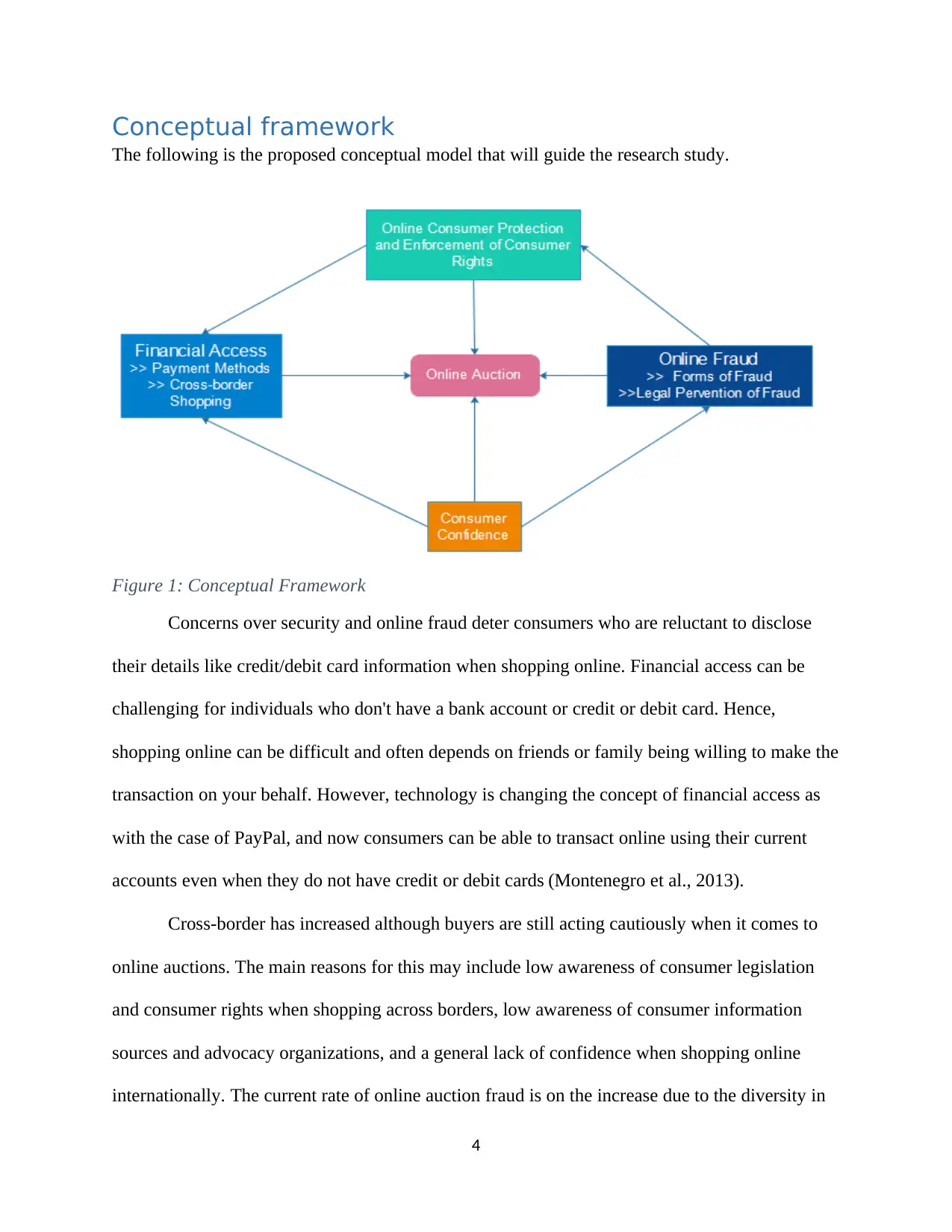
Conceptual framework
The following is the proposed conceptual model that will guide the research study.
Figure 1: Conceptual Framework
Concerns over security and online fraud deter consumers who are reluctant to disclose
their details like credit/debit card information when shopping online. Financial access can be
challenging for individuals who don't have a bank account or credit or debit card. Hence,
shopping online can be difficult and often depends on friends or family being willing to make the
transaction on your behalf. However, technology is changing the concept of financial access as
with the case of PayPal, and now consumers can be able to transact online using their current
accounts even when they do not have credit or debit cards (Montenegro et al., 2013).
Cross-border has increased although buyers are still acting cautiously when it comes to
online auctions. The main reasons for this may include low awareness of consumer legislation
and consumer rights when shopping across borders, low awareness of consumer information
sources and advocacy organizations, and a general lack of confidence when shopping online
internationally. The current rate of online auction fraud is on the increase due to the diversity in
4
The following is the proposed conceptual model that will guide the research study.
Figure 1: Conceptual Framework
Concerns over security and online fraud deter consumers who are reluctant to disclose
their details like credit/debit card information when shopping online. Financial access can be
challenging for individuals who don't have a bank account or credit or debit card. Hence,
shopping online can be difficult and often depends on friends or family being willing to make the
transaction on your behalf. However, technology is changing the concept of financial access as
with the case of PayPal, and now consumers can be able to transact online using their current
accounts even when they do not have credit or debit cards (Montenegro et al., 2013).
Cross-border has increased although buyers are still acting cautiously when it comes to
online auctions. The main reasons for this may include low awareness of consumer legislation
and consumer rights when shopping across borders, low awareness of consumer information
sources and advocacy organizations, and a general lack of confidence when shopping online
internationally. The current rate of online auction fraud is on the increase due to the diversity in
4

the manner in which it can be accomplished. The fraud can be performed during the bidding
process or after the bidding process (Xu, 2015).
Literature Review
Consumer confidence
The recent growth of online shopping is particularly interesting following a period of
uncertainty that led up to the end of the 'dotcom bubble'. Many businesses lost faith in the
potential of the internet for attracting consumers and were reluctant to invest capital and time in
what appeared to be an unstable market. Concerns over security and fraud also deterred
consumers who were reluctant to disclose their details when shopping online. However, the
online market has overcome these setbacks, tempting consumers away from the high street and
catalogue shopping (McLaughlin et al., 2017).
Trustmark's, such as ISIS can fill the gap between consumer uncertainty and online
retailing. When displayed on websites, they can reassure consumers that the retailer conforms to
a set of criteria which signifies greater financial security. Small and medium-sized companies
can benefit from displaying the logo and can also get business advice and online marketing
advice from ISIS (Xu, 2015).
Financial access
For people without a bank account or credit or debit card, shopping online can be difficult
and often depends on friends or family being willing to make the transaction on your behalf.
According to the Department for Work and Pensions, 12% of people in Britain do not have
access to a bank account. Unpublished figures from the Welsh Consumer Council place this
figure at 14% of the Welsh population (Dadfarnia et al., 2020). Our survey also shows that
people from low-income groups are less likely to have a bank account than people in higher-
income groups (78% of DEs have a bank account compared to 90% of ABs).
5
process or after the bidding process (Xu, 2015).
Literature Review
Consumer confidence
The recent growth of online shopping is particularly interesting following a period of
uncertainty that led up to the end of the 'dotcom bubble'. Many businesses lost faith in the
potential of the internet for attracting consumers and were reluctant to invest capital and time in
what appeared to be an unstable market. Concerns over security and fraud also deterred
consumers who were reluctant to disclose their details when shopping online. However, the
online market has overcome these setbacks, tempting consumers away from the high street and
catalogue shopping (McLaughlin et al., 2017).
Trustmark's, such as ISIS can fill the gap between consumer uncertainty and online
retailing. When displayed on websites, they can reassure consumers that the retailer conforms to
a set of criteria which signifies greater financial security. Small and medium-sized companies
can benefit from displaying the logo and can also get business advice and online marketing
advice from ISIS (Xu, 2015).
Financial access
For people without a bank account or credit or debit card, shopping online can be difficult
and often depends on friends or family being willing to make the transaction on your behalf.
According to the Department for Work and Pensions, 12% of people in Britain do not have
access to a bank account. Unpublished figures from the Welsh Consumer Council place this
figure at 14% of the Welsh population (Dadfarnia et al., 2020). Our survey also shows that
people from low-income groups are less likely to have a bank account than people in higher-
income groups (78% of DEs have a bank account compared to 90% of ABs).
5
⊘ This is a preview!⊘
Do you want full access?
Subscribe today to unlock all pages.

Trusted by 1+ million students worldwide
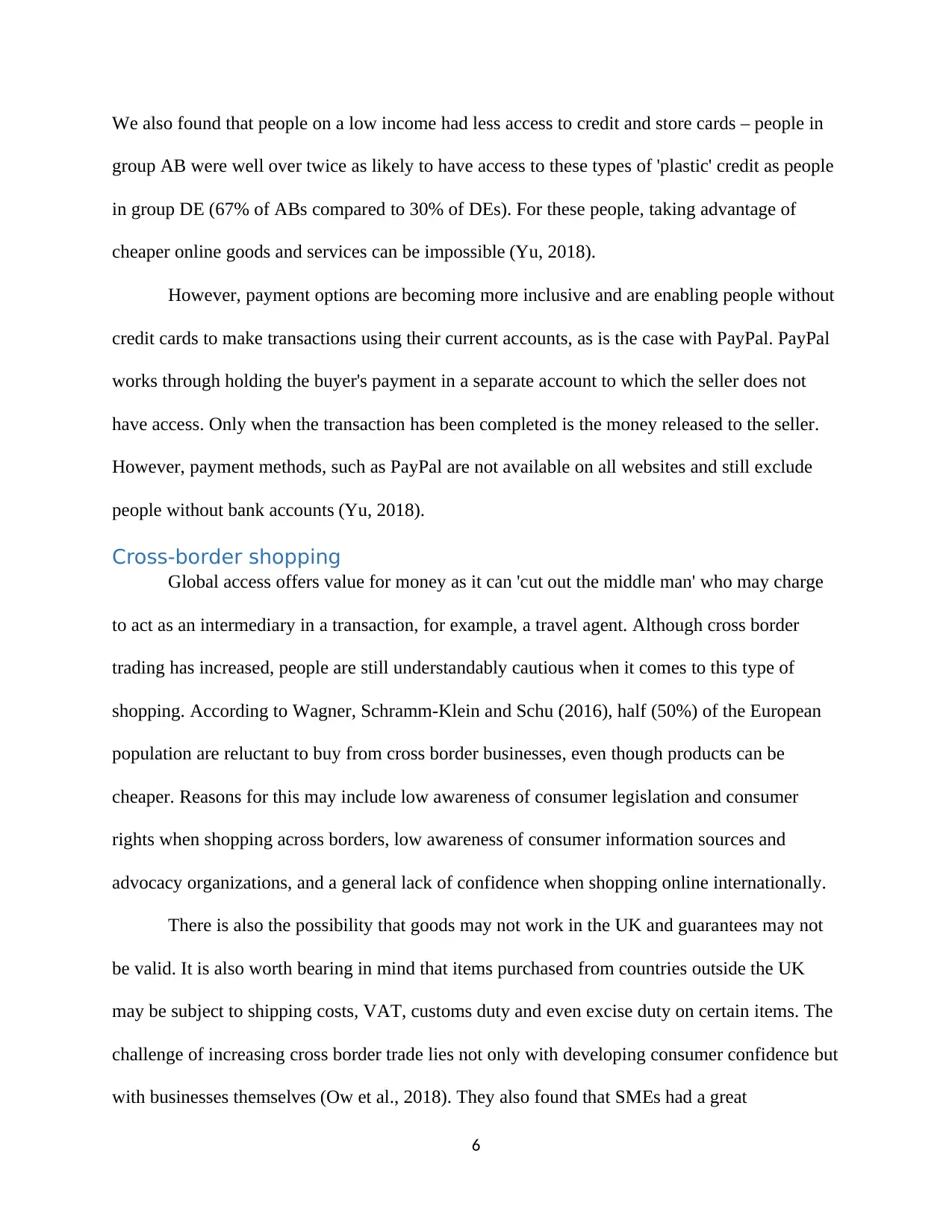
We also found that people on a low income had less access to credit and store cards – people in
group AB were well over twice as likely to have access to these types of 'plastic' credit as people
in group DE (67% of ABs compared to 30% of DEs). For these people, taking advantage of
cheaper online goods and services can be impossible (Yu, 2018).
However, payment options are becoming more inclusive and are enabling people without
credit cards to make transactions using their current accounts, as is the case with PayPal. PayPal
works through holding the buyer's payment in a separate account to which the seller does not
have access. Only when the transaction has been completed is the money released to the seller.
However, payment methods, such as PayPal are not available on all websites and still exclude
people without bank accounts (Yu, 2018).
Cross-border shopping
Global access offers value for money as it can 'cut out the middle man' who may charge
to act as an intermediary in a transaction, for example, a travel agent. Although cross border
trading has increased, people are still understandably cautious when it comes to this type of
shopping. According to Wagner, Schramm-Klein and Schu (2016), half (50%) of the European
population are reluctant to buy from cross border businesses, even though products can be
cheaper. Reasons for this may include low awareness of consumer legislation and consumer
rights when shopping across borders, low awareness of consumer information sources and
advocacy organizations, and a general lack of confidence when shopping online internationally.
There is also the possibility that goods may not work in the UK and guarantees may not
be valid. It is also worth bearing in mind that items purchased from countries outside the UK
may be subject to shipping costs, VAT, customs duty and even excise duty on certain items. The
challenge of increasing cross border trade lies not only with developing consumer confidence but
with businesses themselves (Ow et al., 2018). They also found that SMEs had a great
6
group AB were well over twice as likely to have access to these types of 'plastic' credit as people
in group DE (67% of ABs compared to 30% of DEs). For these people, taking advantage of
cheaper online goods and services can be impossible (Yu, 2018).
However, payment options are becoming more inclusive and are enabling people without
credit cards to make transactions using their current accounts, as is the case with PayPal. PayPal
works through holding the buyer's payment in a separate account to which the seller does not
have access. Only when the transaction has been completed is the money released to the seller.
However, payment methods, such as PayPal are not available on all websites and still exclude
people without bank accounts (Yu, 2018).
Cross-border shopping
Global access offers value for money as it can 'cut out the middle man' who may charge
to act as an intermediary in a transaction, for example, a travel agent. Although cross border
trading has increased, people are still understandably cautious when it comes to this type of
shopping. According to Wagner, Schramm-Klein and Schu (2016), half (50%) of the European
population are reluctant to buy from cross border businesses, even though products can be
cheaper. Reasons for this may include low awareness of consumer legislation and consumer
rights when shopping across borders, low awareness of consumer information sources and
advocacy organizations, and a general lack of confidence when shopping online internationally.
There is also the possibility that goods may not work in the UK and guarantees may not
be valid. It is also worth bearing in mind that items purchased from countries outside the UK
may be subject to shipping costs, VAT, customs duty and even excise duty on certain items. The
challenge of increasing cross border trade lies not only with developing consumer confidence but
with businesses themselves (Ow et al., 2018). They also found that SMEs had a great
6
Paraphrase This Document
Need a fresh take? Get an instant paraphrase of this document with our AI Paraphraser
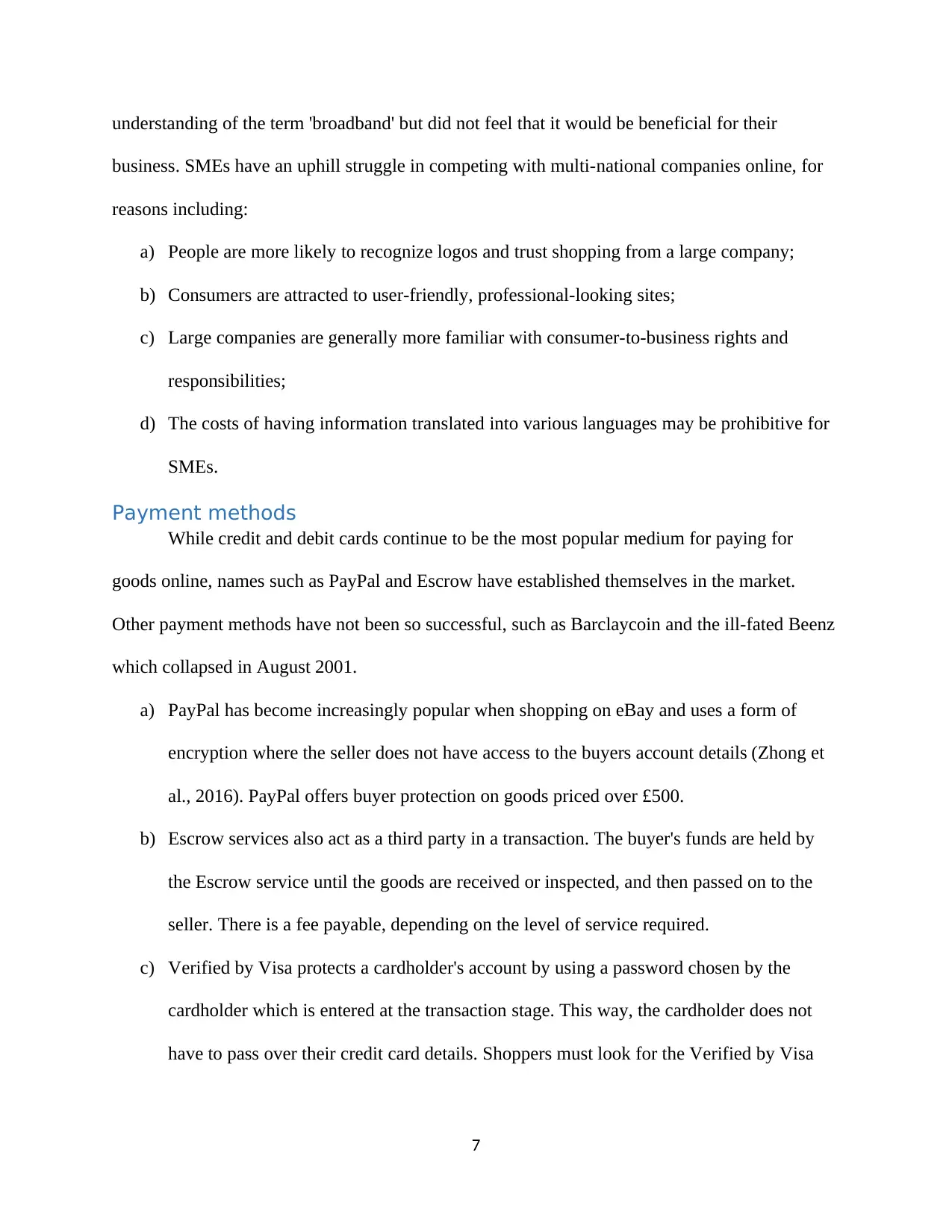
understanding of the term 'broadband' but did not feel that it would be beneficial for their
business. SMEs have an uphill struggle in competing with multi-national companies online, for
reasons including:
a) People are more likely to recognize logos and trust shopping from a large company;
b) Consumers are attracted to user-friendly, professional-looking sites;
c) Large companies are generally more familiar with consumer-to-business rights and
responsibilities;
d) The costs of having information translated into various languages may be prohibitive for
SMEs.
Payment methods
While credit and debit cards continue to be the most popular medium for paying for
goods online, names such as PayPal and Escrow have established themselves in the market.
Other payment methods have not been so successful, such as Barclaycoin and the ill-fated Beenz
which collapsed in August 2001.
a) PayPal has become increasingly popular when shopping on eBay and uses a form of
encryption where the seller does not have access to the buyers account details (Zhong et
al., 2016). PayPal offers buyer protection on goods priced over £500.
b) Escrow services also act as a third party in a transaction. The buyer's funds are held by
the Escrow service until the goods are received or inspected, and then passed on to the
seller. There is a fee payable, depending on the level of service required.
c) Verified by Visa protects a cardholder's account by using a password chosen by the
cardholder which is entered at the transaction stage. This way, the cardholder does not
have to pass over their credit card details. Shoppers must look for the Verified by Visa
7
business. SMEs have an uphill struggle in competing with multi-national companies online, for
reasons including:
a) People are more likely to recognize logos and trust shopping from a large company;
b) Consumers are attracted to user-friendly, professional-looking sites;
c) Large companies are generally more familiar with consumer-to-business rights and
responsibilities;
d) The costs of having information translated into various languages may be prohibitive for
SMEs.
Payment methods
While credit and debit cards continue to be the most popular medium for paying for
goods online, names such as PayPal and Escrow have established themselves in the market.
Other payment methods have not been so successful, such as Barclaycoin and the ill-fated Beenz
which collapsed in August 2001.
a) PayPal has become increasingly popular when shopping on eBay and uses a form of
encryption where the seller does not have access to the buyers account details (Zhong et
al., 2016). PayPal offers buyer protection on goods priced over £500.
b) Escrow services also act as a third party in a transaction. The buyer's funds are held by
the Escrow service until the goods are received or inspected, and then passed on to the
seller. There is a fee payable, depending on the level of service required.
c) Verified by Visa protects a cardholder's account by using a password chosen by the
cardholder which is entered at the transaction stage. This way, the cardholder does not
have to pass over their credit card details. Shoppers must look for the Verified by Visa
7
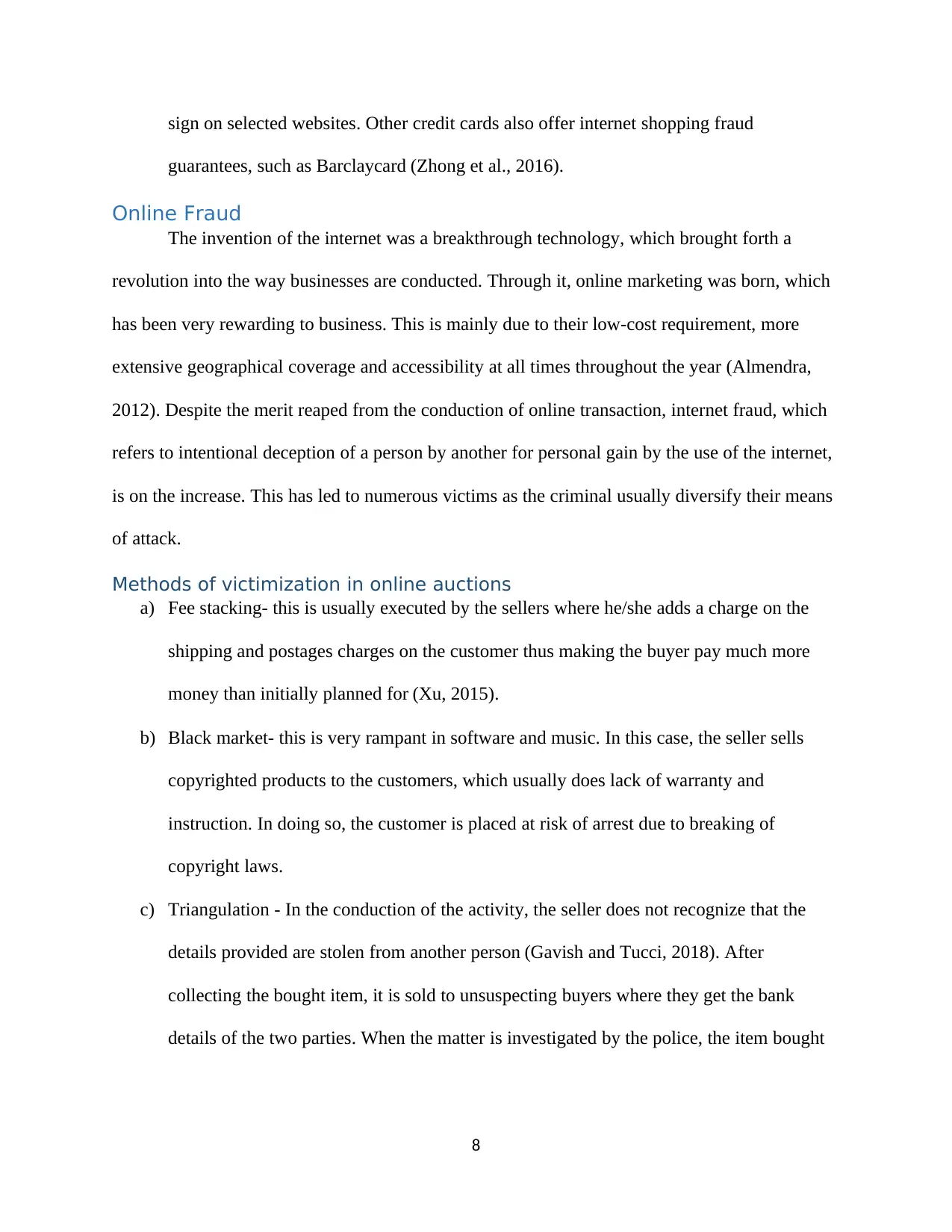
sign on selected websites. Other credit cards also offer internet shopping fraud
guarantees, such as Barclaycard (Zhong et al., 2016).
Online Fraud
The invention of the internet was a breakthrough technology, which brought forth a
revolution into the way businesses are conducted. Through it, online marketing was born, which
has been very rewarding to business. This is mainly due to their low-cost requirement, more
extensive geographical coverage and accessibility at all times throughout the year (Almendra,
2012). Despite the merit reaped from the conduction of online transaction, internet fraud, which
refers to intentional deception of a person by another for personal gain by the use of the internet,
is on the increase. This has led to numerous victims as the criminal usually diversify their means
of attack.
Methods of victimization in online auctions
a) Fee stacking- this is usually executed by the sellers where he/she adds a charge on the
shipping and postages charges on the customer thus making the buyer pay much more
money than initially planned for (Xu, 2015).
b) Black market- this is very rampant in software and music. In this case, the seller sells
copyrighted products to the customers, which usually does lack of warranty and
instruction. In doing so, the customer is placed at risk of arrest due to breaking of
copyright laws.
c) Triangulation - In the conduction of the activity, the seller does not recognize that the
details provided are stolen from another person (Gavish and Tucci, 2018). After
collecting the bought item, it is sold to unsuspecting buyers where they get the bank
details of the two parties. When the matter is investigated by the police, the item bought
8
guarantees, such as Barclaycard (Zhong et al., 2016).
Online Fraud
The invention of the internet was a breakthrough technology, which brought forth a
revolution into the way businesses are conducted. Through it, online marketing was born, which
has been very rewarding to business. This is mainly due to their low-cost requirement, more
extensive geographical coverage and accessibility at all times throughout the year (Almendra,
2012). Despite the merit reaped from the conduction of online transaction, internet fraud, which
refers to intentional deception of a person by another for personal gain by the use of the internet,
is on the increase. This has led to numerous victims as the criminal usually diversify their means
of attack.
Methods of victimization in online auctions
a) Fee stacking- this is usually executed by the sellers where he/she adds a charge on the
shipping and postages charges on the customer thus making the buyer pay much more
money than initially planned for (Xu, 2015).
b) Black market- this is very rampant in software and music. In this case, the seller sells
copyrighted products to the customers, which usually does lack of warranty and
instruction. In doing so, the customer is placed at risk of arrest due to breaking of
copyright laws.
c) Triangulation - In the conduction of the activity, the seller does not recognize that the
details provided are stolen from another person (Gavish and Tucci, 2018). After
collecting the bought item, it is sold to unsuspecting buyers where they get the bank
details of the two parties. When the matter is investigated by the police, the item bought
8
⊘ This is a preview!⊘
Do you want full access?
Subscribe today to unlock all pages.

Trusted by 1+ million students worldwide
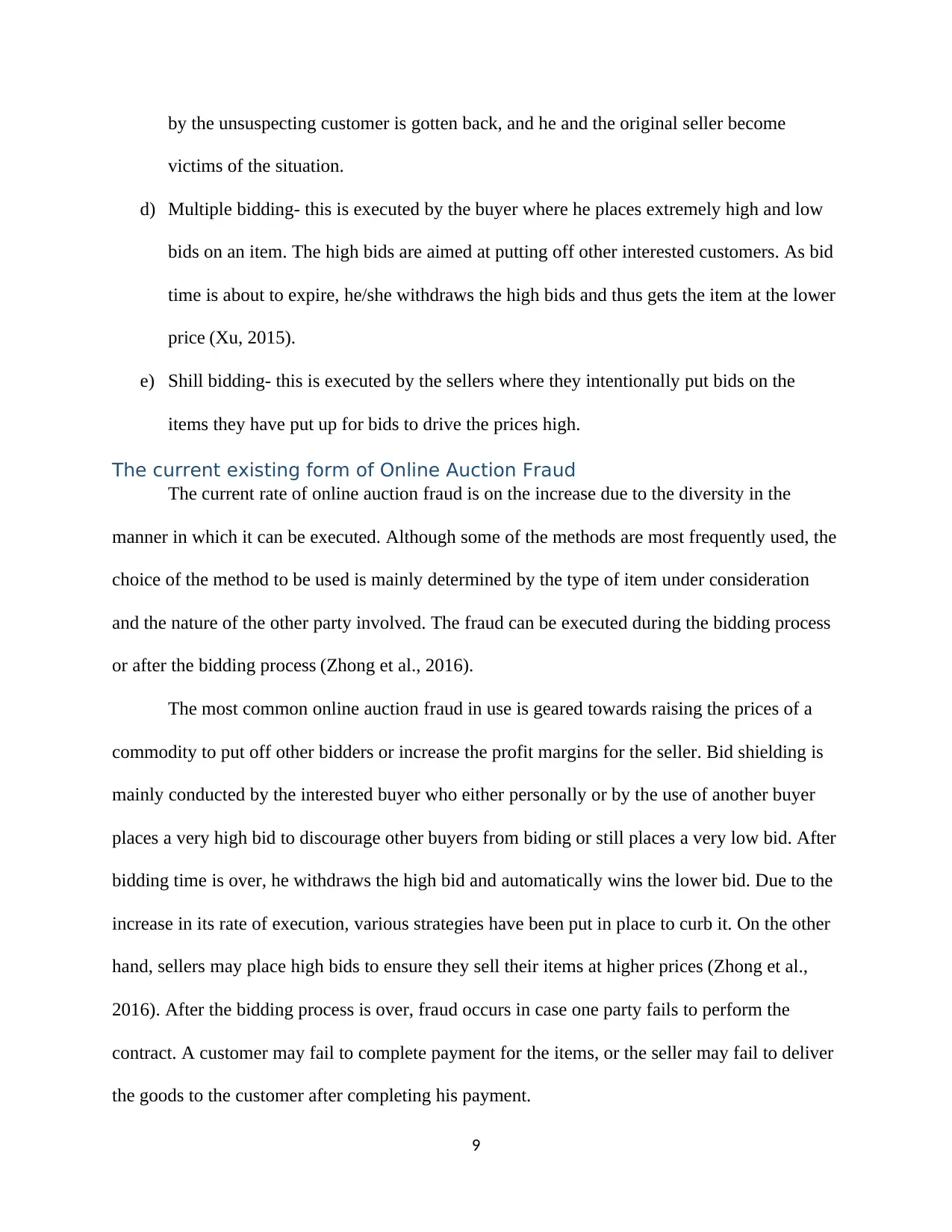
by the unsuspecting customer is gotten back, and he and the original seller become
victims of the situation.
d) Multiple bidding- this is executed by the buyer where he places extremely high and low
bids on an item. The high bids are aimed at putting off other interested customers. As bid
time is about to expire, he/she withdraws the high bids and thus gets the item at the lower
price (Xu, 2015).
e) Shill bidding- this is executed by the sellers where they intentionally put bids on the
items they have put up for bids to drive the prices high.
The current existing form of Online Auction Fraud
The current rate of online auction fraud is on the increase due to the diversity in the
manner in which it can be executed. Although some of the methods are most frequently used, the
choice of the method to be used is mainly determined by the type of item under consideration
and the nature of the other party involved. The fraud can be executed during the bidding process
or after the bidding process (Zhong et al., 2016).
The most common online auction fraud in use is geared towards raising the prices of a
commodity to put off other bidders or increase the profit margins for the seller. Bid shielding is
mainly conducted by the interested buyer who either personally or by the use of another buyer
places a very high bid to discourage other buyers from biding or still places a very low bid. After
bidding time is over, he withdraws the high bid and automatically wins the lower bid. Due to the
increase in its rate of execution, various strategies have been put in place to curb it. On the other
hand, sellers may place high bids to ensure they sell their items at higher prices (Zhong et al.,
2016). After the bidding process is over, fraud occurs in case one party fails to perform the
contract. A customer may fail to complete payment for the items, or the seller may fail to deliver
the goods to the customer after completing his payment.
9
victims of the situation.
d) Multiple bidding- this is executed by the buyer where he places extremely high and low
bids on an item. The high bids are aimed at putting off other interested customers. As bid
time is about to expire, he/she withdraws the high bids and thus gets the item at the lower
price (Xu, 2015).
e) Shill bidding- this is executed by the sellers where they intentionally put bids on the
items they have put up for bids to drive the prices high.
The current existing form of Online Auction Fraud
The current rate of online auction fraud is on the increase due to the diversity in the
manner in which it can be executed. Although some of the methods are most frequently used, the
choice of the method to be used is mainly determined by the type of item under consideration
and the nature of the other party involved. The fraud can be executed during the bidding process
or after the bidding process (Zhong et al., 2016).
The most common online auction fraud in use is geared towards raising the prices of a
commodity to put off other bidders or increase the profit margins for the seller. Bid shielding is
mainly conducted by the interested buyer who either personally or by the use of another buyer
places a very high bid to discourage other buyers from biding or still places a very low bid. After
bidding time is over, he withdraws the high bid and automatically wins the lower bid. Due to the
increase in its rate of execution, various strategies have been put in place to curb it. On the other
hand, sellers may place high bids to ensure they sell their items at higher prices (Zhong et al.,
2016). After the bidding process is over, fraud occurs in case one party fails to perform the
contract. A customer may fail to complete payment for the items, or the seller may fail to deliver
the goods to the customer after completing his payment.
9
Paraphrase This Document
Need a fresh take? Get an instant paraphrase of this document with our AI Paraphraser
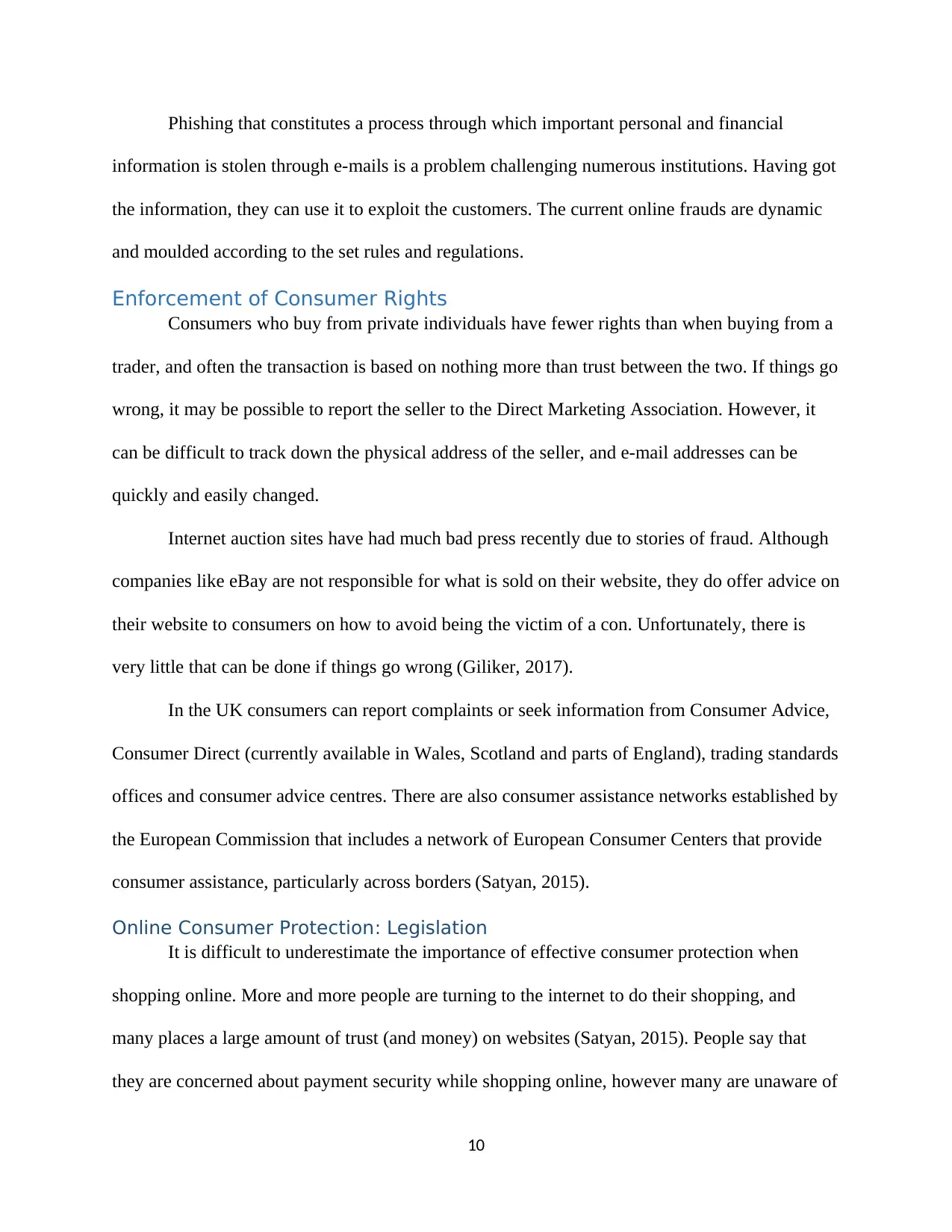
Phishing that constitutes a process through which important personal and financial
information is stolen through e-mails is a problem challenging numerous institutions. Having got
the information, they can use it to exploit the customers. The current online frauds are dynamic
and moulded according to the set rules and regulations.
Enforcement of Consumer Rights
Consumers who buy from private individuals have fewer rights than when buying from a
trader, and often the transaction is based on nothing more than trust between the two. If things go
wrong, it may be possible to report the seller to the Direct Marketing Association. However, it
can be difficult to track down the physical address of the seller, and e-mail addresses can be
quickly and easily changed.
Internet auction sites have had much bad press recently due to stories of fraud. Although
companies like eBay are not responsible for what is sold on their website, they do offer advice on
their website to consumers on how to avoid being the victim of a con. Unfortunately, there is
very little that can be done if things go wrong (Giliker, 2017).
In the UK consumers can report complaints or seek information from Consumer Advice,
Consumer Direct (currently available in Wales, Scotland and parts of England), trading standards
offices and consumer advice centres. There are also consumer assistance networks established by
the European Commission that includes a network of European Consumer Centers that provide
consumer assistance, particularly across borders (Satyan, 2015).
Online Consumer Protection: Legislation
It is difficult to underestimate the importance of effective consumer protection when
shopping online. More and more people are turning to the internet to do their shopping, and
many places a large amount of trust (and money) on websites (Satyan, 2015). People say that
they are concerned about payment security while shopping online, however many are unaware of
10
information is stolen through e-mails is a problem challenging numerous institutions. Having got
the information, they can use it to exploit the customers. The current online frauds are dynamic
and moulded according to the set rules and regulations.
Enforcement of Consumer Rights
Consumers who buy from private individuals have fewer rights than when buying from a
trader, and often the transaction is based on nothing more than trust between the two. If things go
wrong, it may be possible to report the seller to the Direct Marketing Association. However, it
can be difficult to track down the physical address of the seller, and e-mail addresses can be
quickly and easily changed.
Internet auction sites have had much bad press recently due to stories of fraud. Although
companies like eBay are not responsible for what is sold on their website, they do offer advice on
their website to consumers on how to avoid being the victim of a con. Unfortunately, there is
very little that can be done if things go wrong (Giliker, 2017).
In the UK consumers can report complaints or seek information from Consumer Advice,
Consumer Direct (currently available in Wales, Scotland and parts of England), trading standards
offices and consumer advice centres. There are also consumer assistance networks established by
the European Commission that includes a network of European Consumer Centers that provide
consumer assistance, particularly across borders (Satyan, 2015).
Online Consumer Protection: Legislation
It is difficult to underestimate the importance of effective consumer protection when
shopping online. More and more people are turning to the internet to do their shopping, and
many places a large amount of trust (and money) on websites (Satyan, 2015). People say that
they are concerned about payment security while shopping online, however many are unaware of
10
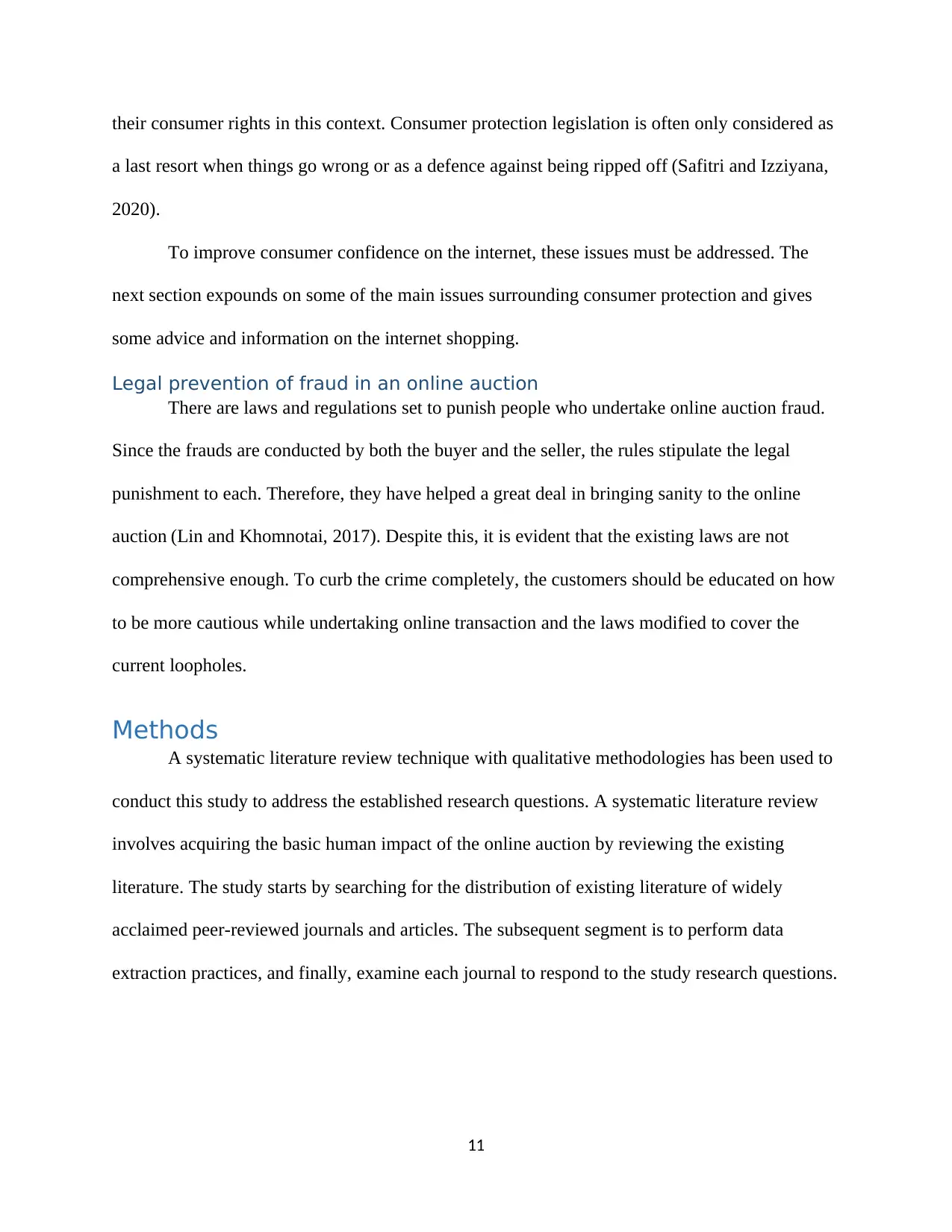
their consumer rights in this context. Consumer protection legislation is often only considered as
a last resort when things go wrong or as a defence against being ripped off (Safitri and Izziyana,
2020).
To improve consumer confidence on the internet, these issues must be addressed. The
next section expounds on some of the main issues surrounding consumer protection and gives
some advice and information on the internet shopping.
Legal prevention of fraud in an online auction
There are laws and regulations set to punish people who undertake online auction fraud.
Since the frauds are conducted by both the buyer and the seller, the rules stipulate the legal
punishment to each. Therefore, they have helped a great deal in bringing sanity to the online
auction (Lin and Khomnotai, 2017). Despite this, it is evident that the existing laws are not
comprehensive enough. To curb the crime completely, the customers should be educated on how
to be more cautious while undertaking online transaction and the laws modified to cover the
current loopholes.
Methods
A systematic literature review technique with qualitative methodologies has been used to
conduct this study to address the established research questions. A systematic literature review
involves acquiring the basic human impact of the online auction by reviewing the existing
literature. The study starts by searching for the distribution of existing literature of widely
acclaimed peer-reviewed journals and articles. The subsequent segment is to perform data
extraction practices, and finally, examine each journal to respond to the study research questions.
11
a last resort when things go wrong or as a defence against being ripped off (Safitri and Izziyana,
2020).
To improve consumer confidence on the internet, these issues must be addressed. The
next section expounds on some of the main issues surrounding consumer protection and gives
some advice and information on the internet shopping.
Legal prevention of fraud in an online auction
There are laws and regulations set to punish people who undertake online auction fraud.
Since the frauds are conducted by both the buyer and the seller, the rules stipulate the legal
punishment to each. Therefore, they have helped a great deal in bringing sanity to the online
auction (Lin and Khomnotai, 2017). Despite this, it is evident that the existing laws are not
comprehensive enough. To curb the crime completely, the customers should be educated on how
to be more cautious while undertaking online transaction and the laws modified to cover the
current loopholes.
Methods
A systematic literature review technique with qualitative methodologies has been used to
conduct this study to address the established research questions. A systematic literature review
involves acquiring the basic human impact of the online auction by reviewing the existing
literature. The study starts by searching for the distribution of existing literature of widely
acclaimed peer-reviewed journals and articles. The subsequent segment is to perform data
extraction practices, and finally, examine each journal to respond to the study research questions.
11
⊘ This is a preview!⊘
Do you want full access?
Subscribe today to unlock all pages.

Trusted by 1+ million students worldwide
1 out of 19